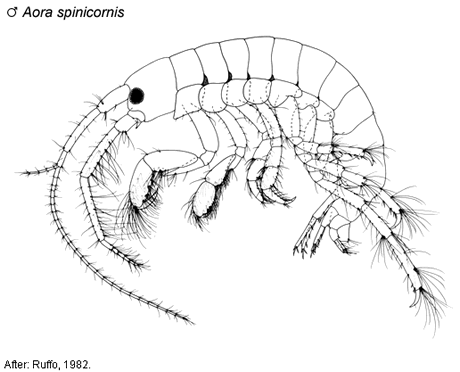 |
||||||
|
|
|
|
|
|
North-eastern Atlantic Amphipoda: AoridaeR. King & A.A. MyersAora spinicornis Afonso, 1976Aora gracilis. --Della Valle, 1893: 407, pl. 2, fig. 9; pl. 12, figs. 25-39; pl. 56, fig. 37 (non A. gacilis Bate, 1857). Aora atlantidea. --Myers, 1973a: 291, figs. 7-13 (non A. atlantidea Reid, 1951: 252, fig. 45). Aora spinicornis Afonso, 1976: 19, figs. 3-8. --Myers, 1982a: 114-116, figs. 75-76. Type material. HOLOTYPE: male, 5.4 mm, MUP No. 318a. PARATYPES: 4 females, MUP No. 318a. Type locality. Ilha de São Miguel, Azores. Description. Based on Myers, 1982a: 114-116, figs. 75-76. Head. Rostrum absent or vestigial; Lateral cephalic lobes apically round, anteroventral margin moderately excavate, moderately recessed. Antenna 1 flagellum with 21 or more articles; accessory flagellum present and multiarticulate. Antenna 2 with few long setae. Labium with fine setae and stout setae. Maxilla 1 inner plate with 1 long pectinate apical seta. Maxilliped basis without strong flange on anterior margin. Mandible, palp article 3 subequal to 2, posterior margin straight or weakly falcate or widest medially, mandible palp posterior margin setae of more than two distinct lengths. Peraeon. Sternal spines absent. Gnathopod 1 enlarged in males only; coxa distinctly produced anterodistally, acute; basis slender, much less than half as broad as long, without a spine, anterior margin without stridulating ridges, posterodistal margin with setae sparse or absent, anterodistal margin with flange weak or absent, with a weak distomedial lobe or absent; ischium anterior margin without flange, posterior margin with setae sparse or absent; merus greatly elongated, as long as or longer than elongate carpus, distally free, produced along posterior margin of carpus, curved, apically acute, posterior margin with sparse setae or setae absent; carpus one and one third to one and one half length of propodus, anterior margin without stridulating ridges, with setae sparse or absent, anterior surface with no spine, without an oblique row of long setae on medial face, posterior margin without spines; propodus shorter than carpus, anterior margin weakly to moderately setiferous, posterior margin straight or evenly convex, palm absent; dactylus more than half length of propodus. Gnathopod 2 subchelate; basis anterodistal margin with flange, posterodistal margin without robust setae; with few setae along length of basis; carpus subequal with or shorter than propodus, anterior margin not lobate, moderately to sparsely setiferous; propodus densely setose, palm with robust seta(e) defining palm. Pereopod 6 basis not or weakly produced posterodistally. Pereopod 7 significantly greater than 125% length of pereopod 6. Pleon. Epimeron 3 posterodistal margin with a small notch. Uropod 1 biramous, rami rami subequal, peduncle much longer than broad, distoventral interramal spine shorter than peduncle. Uropod 2 peduncle without distoventral interramal spine or with vestigial spine. Uropod 3 biramous, rami subequal, inner ramus subequal with length of peduncle. Telson with distal fine setae only. Habitat. Among hydroids, phanerogams and algae, and on sandy bottoms (Myers, 1982a). Depth zones. Littoral. Distribution. Atlantic Ocean (Bay of Biscay to Azores) and Mediterranean Sea.
(Variant) Female (sexually dimorphic characters). Peraeon. Gnathopod 1 coxa distinctly produced anterodistally, sub-acute; merus not greatly elongated, fused along its entire length with carpus, without posterodistal spine; carpus two thirds length of propodus; propodus longer than carpus, palm present, palm delimited from posterior margin, margin entire, palm defined by rounded or oblique corner or corner undefined, with robust seta defining palm; significantly overlapping palm. Gnathopod 2 basis anterodistal margin without flange; propodus moderately to sparsely setose.
Cite this publication as: 'King, R. & A.A. Myers (2001 onwards). North-eastern Atlantic Amphipoda: Aoridae. Version 1: 1 September 2001. https://crustacea.net/'. Dallwitz (1980) and Dallwitz, Paine and Zurcher (1993, 1995, 2000) should also be cited (see References). |
|
|
|
|
|
|
|
|
|
Copyright © Australian Museum, 2021
Australian Museum website


